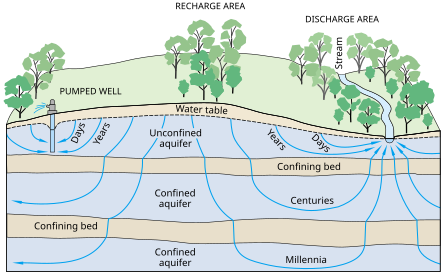Groundwater
Groundwater
In this post, you will learn all about the groundwater, which is an important source of water on Earth. You will learn about what groundwater is, how we can use it, how it might be polluted, and much more!
Groundwater is the water underground. The water in the groundwater zone is collected when rainwater and melted snow seeps into soils and rocks. It seeps into the ground
until it reaches the impermeable layer, where the water is held above. Sometimes, the soil and rocks underground allow a large amount of water to store between them. This water reservoir is called an aquifer {1}. The upper surface, or boundary, of the groundwater, is called a water table. In urban areas with a large population, groundwater is pumped out to use as drinking water. This causes a lower water table. The water table might raise as well. Heavy precipitation such as rainfall, ice-jams, and storms might cause the water table to rise, which would lead to flooding.
Groundwater can be found in groundwater zones that are located underground. Groundwater is located around the world but it’s quality and quantity might be different. An example is India, which is facing extreme water shortage {2}. Groundwater can also be found in the wells of many rural areas. Groundwater is pumped out from the ground and used as drinking water or irrigation. Groundwater is always moving underground and will reach the ocean, lakes, or rivers eventually. Groundwater is also an excellent resource for industries. Factories use it as a necessity of production.
Liquid fresh water is commonly found in the groundwater zone. There are two types of water on Earth, fresh water and salt water. Fortunately, groundwater is fresh water meaning it doesn’t contain any salt and we can drink it. Groundwater is a liquid means it’s unlike glaciers, which are solid; nor vapour, which is gas. However, it will be different when the water source is polluted. For example, seawater can seep into groundwater as well in some coastal areas. Causing the water underground contaminated with salt. This is known as “saltwater intrusion”. Human-made physical contaminants can also pollute the groundwater. Physical contaminants are all materials that do not dissolve in water. An example of Human-made physical contaminants is road salt {3}.
Humans and other living organisms use the groundwater to drink. Humans pump the groundwater out from underground and use it as drinking water. There are 8.9 million people or 30.3% of the population in Canada who rely on groundwater. Moreover, statistics from Canada.ca shows that 100% of the population in Prince Edward Island rely on groundwater.{4} The organisms such as protozoa, unicellular organisms are commonly found in groundwater. Because protozoa lack a cell wall, they live in water not only because they feed on it, water is also protecting them. Protozoa also feed on the bacterias in the groundwater. Molds and fungi can be found in groundwater as well. Since aquifers are moist and have a lack of sunshine. They live in places with plenty of oxygen available, such as some places near the land surface {5}.
Groundwater is truly an amazing source of water that exists on Earth. There are approximately 300.2 billion liters of groundwater, which is 0.01% of the total water on Earth {6}. Although groundwater is classified as a renewable water source, it takes a long time to refill an overused aquifer. For example, It would take about 6,000 years to naturally refill the Ogallala Aquifer if it was empty {7}. Irrigation is the largest use of groundwater in the United States {8}.
As we have learned in this passage, now we know that groundwater is the water that can be found underground; humans can use the groundwater for drinking; it might be polluted when human-made or natural substances dissolved in it. Groundwater is an essential water source for all of us!

(image link: https://upload.wikimedia.org/wikipedia/commons/thumb/c/c7/Groundwater_flow.svg/444px-Groundwater_flow.svg.png)
Bibliography
{1} About aquifer
{2} Water shortage
{3} About groundwater contamination
{4} Statistics about the population in Canada who rely on groundwater
{5} Microorganisms in groundwater
Comments